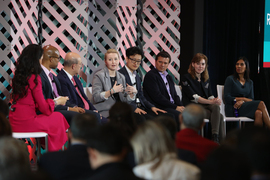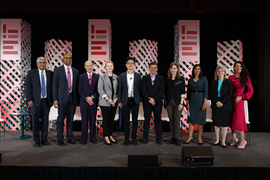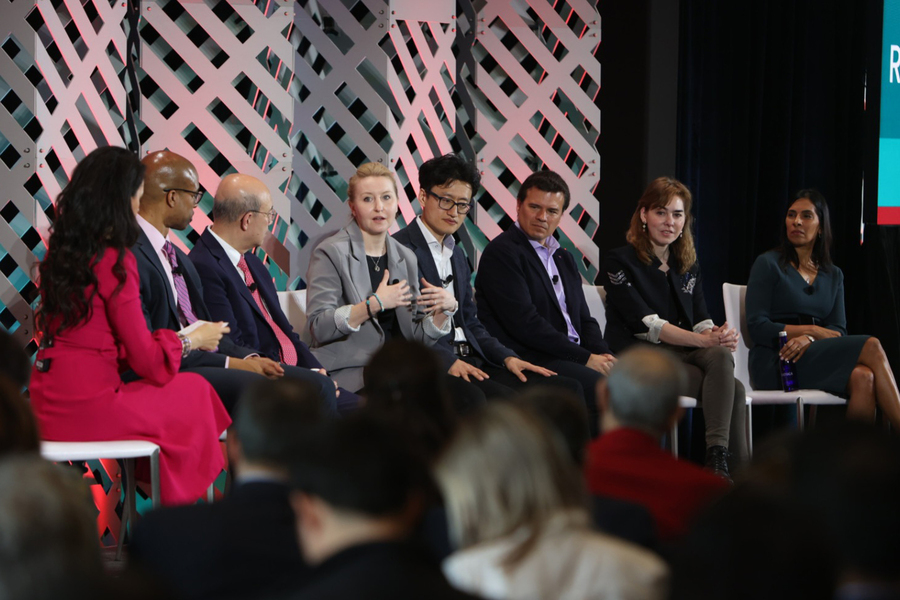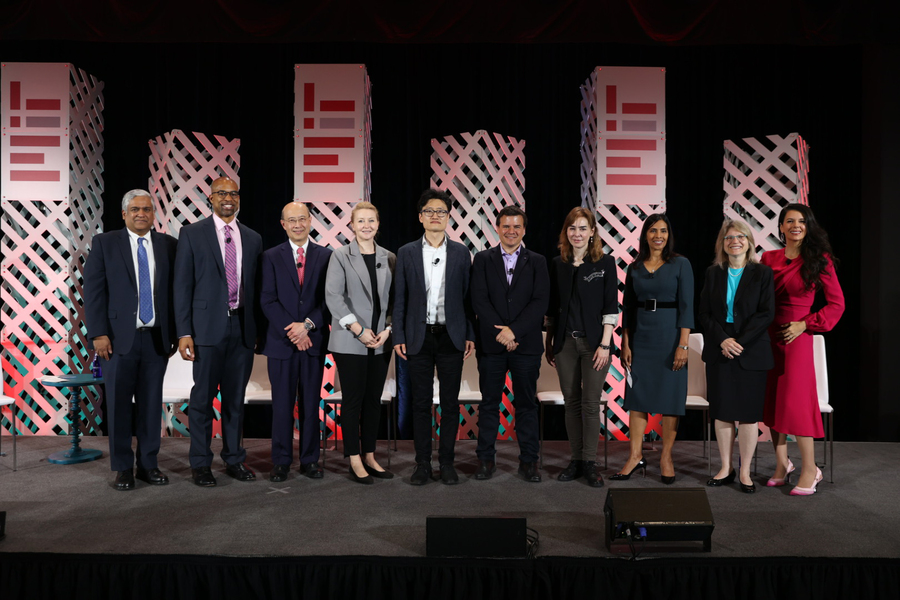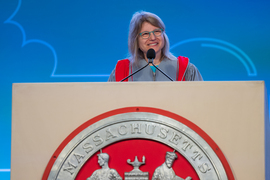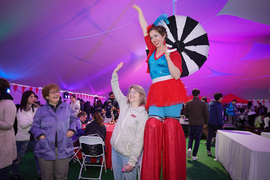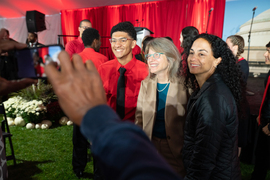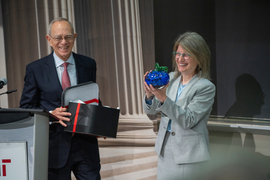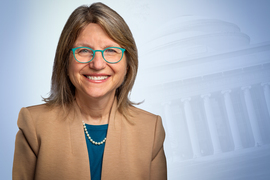Big ideas took the stage on Monday morning, ahead of the inauguration of MIT’s 18th president, Sally Kornbluth. As final preparations were underway on Killian Court for the afternoon’s ceremonies, members of the MIT community gathered to welcome Kornbluth with an academic symposium exploring the theme “Where Big Ideas Come From — and Why They Matter.”
Held at MIT’s Samberg Conference Center and streamed online, the symposium featured eight MIT faculty members representing a range of disciplines across the Institute. They took turns presenting their research and sharing their perspectives on how MIT can cultivate ideas and innovations to meet the major challenges of the world today.
“It’s wonderful to see you all at the start of quite an exciting day,” Kornbluth said, greeting the audience. “MIT has a bit more than 1,000 faculty members spread across dozens of fields. So you can consider the brilliant speakers today as a sort of tasting menu to whet your appetite to the rich intellectual environment of MIT.”
The event was convened by Anantha Chandrakasan, dean of the School of Engineering and the Vannevar Bush Professor of Electrical Engineering and Computer Science, who kicked off the symposium by enthusiastically welcoming Kornbluth to MIT.
“I’ve been inspired by your seemingly unbounded curiosity and passion for learning,” Chandrakasan said. “These two qualities that we find so important in our students, we find reflected in you.”
Chandrakasan went on to emphasize the need for curiosity and collaboration across multiple fields in tackling the world’s most pressing problems.
“As our global challenges become increasingly urgent, now more than ever we are in need of big ideas, which our faculty, students, staff, and alumni are working hard to generate,” he continued. “Problems like climate change simply cannot be solved unless researchers from nearly every discipline collaborate. Today we’ll hear of ideas that span disciplines.”
Finding a flow
Cullen Buie, associate professor of mechanical engineering, was the first speaker to take the stage. In opening his talk, Buie marveled at the progress of gene therapy, pointing out that the technology has advanced in recent years such that some patients’ own cells can be genetically altered to eradicate diseases such as sickle cell disease and certain types of leukemia.
“These amazing technologies are ushering in a new frontier,” Buie said. “But many patients will not receive these therapies.”
The reason, he found, was that it simply takes too long to make these therapies. And the major bottleneck stems from one specific step in the manufacturing process: the delivery of genetic material into a patient’s cells. In learning about the different ways in which researchers are attempting to streamline gene therapy, Buie came across a company that was close to automating the entire manufacturing process, save for the crucial step of gene delivery, which involved painstaking, highly individualized labwork.
“This company had created a sports car for cell engineering, but it was limited to second gear because the gene delivery was too slow,” Buie said.
This realization kicked off an idea: What if genes could be delivered in a faster, continuously flowing fashion? The idea sparked Kytopen, a startup co-founded by Buie and former MIT postdoc and research scientist Paolo Garcia, who developed a new technology to quickly and continuously deliver genetical material into human cells.
The technology, he says, is “poised to revolutionize the field.” And closer to home, the idea would help patients like Buie’s own son, who has sickle cell disease and has experienced the excruciating “pain crises” that the condition brings on.
With Kytopen, and the technologies that Buie and his colleagues are developing, he hopes to have a solution for his son and others who suffer from genetic diseases.
“These big ideas come from you, from me, from anyone who sees someone like my son suffering, and they decide they want to do something about it,” Buie said.
Medical subscriptions
As innovations are made in medicine, there will also need to be innovations in how we finance them — a point that was made by Andrew Lo, the Charles E. and Susan T. Harris Professor of Finance, who followed Buie’s talk. He began by echoing Buie’s excitement for new gene therapies that target and correct “typos” in DNA. These therapies have been proven to cure certain rare diseases, and are on the verge of success with more common diseases.
“This is a really big deal,” Lo said. “The problem is, these cures don’t come cheap. There are eye-popping numbers that come with these therapies. They’re hitting health care budgets really hard. Can we afford them?”
Lo believes that we can, with a new, subscription-based model that he likens to Netflix for health care. He envisions a company’s health plan could pay a subscription fee directly to various drug manufacturers, such as Novartis, and these drug manufacturers in turn would administer therapies to patients with zero to little additional cost.
“A Netflix model could offer a menu of therapies and could give more access to therapies,” Lo said.
He and a colleague, Yutong Sun, have founded a company, Quantile Health, to develop and test such a subscription-based health plan.
“Finance doesn’t always have to be a zero-sum game,” Lo said. “With the right kind of financing, scale, and business model, we can do well by doing good. And we can do it now.”
A longstanding investment
Anne White, associate provost and associate vice president for research administration, spoke next, about the promise of fusion technology in providing electricity at a large scale.
“If you could harness the energy released from fusion reactions from deuterium and tritium, you could power a city the size of Boston with a pickup truck of fuel,” White said. “No greenhouse emissions, minimal waste, little land usage, small environmental impact. This is the huge promise of fusion.”
That promise, White said, is closer to realization than ever, thanks to a convergence of four essential pieces: community consensus and mature science, policy and public private partnership, private funding, and longstanding university leadership.
MIT, she pointed out, has been significantly involved this endeavor, in part through the continued work of researchers in the Plasma Science and Fusion Center, the development of a new superconducting magnet technology to enable smaller, faster fusion devices, and various MIT startups focused on advancing key steps of fusion technology.
“The fusion ecosystem is flourishing,” White said. “We could be 15 years away from a demonstration of electricity from fusion — a very clean, very safe, nearly unlimited source of low-carbon energy.”
“Big ideas don’t come out of thin air,” she concluded. “They come from longstanding investment in people and their ideas that might just change the world.”
Accounting for carbon
Jinhua Zhao is looking to decarbonize transportation by changing the way we behave. Zhao, who is the Edward and Joyce Linde Associate Professor of City and Transportation Planning, is also the founder and director of the MIT Mobility Initiative, where he brings together work across the Institute on transportation research, education, entrepreneurship, and civic engagement.
Zhao opened his talk with a picture of Beijing traffic today — an image that he pointed out is not too different from Boston gridlock. As a counterpart, he showed the same region of Beijing, 40 years ago, its streets filled with pedestrians, bicyclists, and electric trolleys.
“We call this sustainable, low-carbon, active traffic — all this beautiful vocabulary,” Zhao said. “In the past 40 years, we have moved away from this paradigm” in favor of a gasoline-based infrastructure. Now, in order to move away from a gasoline economy, he says electrification is key. But so is a change in our own behavior.
“What did you have for dinner last night? How much did that cost you? How much time did it take you? How much carbon did that meal cost?” Zhao said. “Most of us would have no clue. We wouldn’t even have the order of magnitude right.”
“We want to establish money, time, and carbon as fundamental units of societal accounting,” said Zhao, who has set up a company, Tram Global, that establishes a digital marketplace that aims to reward those who take certain actions to reduce their daily carbon emissions.
“To change individual behavior is hard,” said Zhao. “Norms are sticky, and take about a generation to change. But maybe we can accelerate that process just enough to save our planet.”
A musical pivot
Eran Egozy, professor of the practice in music technology, was next to speak, participating via video. The co-founder of the videogame developer Harmonix took the symposium audience through the early days of the company and the development of its most popular game, “Guitar Hero,” which aimed to let every player experience the joy of making music.
Egozy, who is himself a clarinetist, remembers the painful early days of learning the instrument — an experience that defeats many beginners.
“If you can overcome this chasm, and get to the point where you derive real pleasure from playing your instrument, you can launch yourself into this beautiful world of music making,” he said.
While this vision ultimately led to a very successful product in “Guitar Hero,” Egozy said the team developed 10 games along the way that were commercial failures.
“But we learned from our mistakes, pivoted and adjusted, lived another day, and made another product or game that was a little better than the previous one,” he said.
“Guitar Hero” has since inspired many to take up actual instruments, including the rapper and singer/songwriter Post Malone and composer and guitarist Yasmin Williams. Ergozy closed his talk by playing a video of Williams playing, in a twist of “karmic awesomeness,” a cover of Post Malone’s “Sunflower.”
A new twist
Pablo Jarillo-Herrero, the Cecil and Ida Green Professor of Physics, next introduced the attendees to quantum matter and the study of multiple interacting particles at the quantum scale. He pointed out that the behavior of a single particle such as an electron is well-understood. But when part of a cloud of many interacting particles, electrons collectively demonstrate entirely new and unknown behaviors that can result in “fascinating states of matter.”
Jarillo-Herrero and his colleagues have discovered many new quantum states of matter that can arise when two layers of carbon atoms, or sheets of graphene, are placed atop each other and twisted just slightly. At certain angles, the particles within the sheets can take on unexpected, exotic properties, such as superconductivity, that were not possible with each sheet separately.
“With this new platform, we have realized all of the phases of quantum matter known in nature, and a few new ones,” Jarillo-Herrero said. “We don’t understand why this happens, but there’s hope that if we can, we can design new technologies, such as better magnets for fusion technology.”
A radio world
Dina Katabi, the Thuan and Nicole Pham Professor of Electrical Engineering and Computer Science, is harnessing the behavior of radio signals to continuously and noninvasively read a patient’s health status.
Rather than hook patients up to electrodes and monitors to track their heartbeats, brain activity, and breathing, she says that wireless devices that emit radio signals could be sensitive enough to track a patient’s vitals. Her group has developed devices that they are currently using to collect data from patients with Parkinson’s disease, Alzheimer’s disease, Crohn’s disease, and Covid-19, and are using artificial intelligence and machine learning techniques to decipher meaningful patterns in the data.
For Parkinson’s in particular, they are hoping the radio-based monitoring could help to diagnose the disease much earlier in its progression. For most patients, a diagnosis comes only after motor symptoms such as tremors and stiffness become apparent. But, Katabi noted, even James Parkinson, who was first to describe the disease’s symptoms, noticed changes in breathing early on in the disease.
Katabi wondered: Could Parkinson’s be diagnosed much earlier through changes in a patient’s breathing? She and her colleagues are gathering data from patients, and developing AI methods to pick up on meaningful patterns in breathing that could enable an early diagnosis.
“We envision this being in every home, like smoke detectors,” says Katabi, who proposed that devices could be programmed to check for signs of various diseases, conditions, and behaviors. “We could write applications to check on Grandma if she’s taking her medications,” she offered.
Iterative invention
Sangeeta Bhatia, the John J. and Dorothy Wilson Professor of Health Sciences and Technology and of Electrical Engineering and Computer Science, emphasized the importance of “convergence” in cultivating new inventions. Her group combines the fields of nanotechnology and medicine to develop new therapies for patients with cancer by harnessing the unique properties of materials at the nanoscale.
“Just as these materials have unique physical properties at nanoscale, they also have unique biological properties,” Bhatia said. “How they traffic inside the body changes with their size. So, you can design materials that speak the language of biology.”
To her point, Bhatia’s group has recently developed an ultrasensitive sensor in the form of particles that are each 1/1,000 the width of a human hair and that can travel through a patient’s bloodstream and detect the presence of cancer. The particles are small enough to pass through the kidney and out of the body, making the sensor “completely noninvasive.”
The team set up a company, Glympse Bio, to advance the technology, and has explored a variety of methods to deliver the sensors, including as a urine test akin to a pregnancy test, and an oral test similar to a breathalyzer.
“Invention is an iterative process,” Bhatia said. “I imagine it’s like writing a song. You start in one direction and make it up as you go. Invention begets invention.”
Taking note
The symposium closed out with a roundtable discussion moderated by Boston Globe Media CEO Linda Pizzuti Henry SM ’05, who asked the group to offer advice for Kornbluth as she takes on the MIT presidency.
“Climate change is a big one,” White said. “We will have to pull from every discipline, every department, will have to inspire people through art and music to think about the planet, and combine life sciences with computing to connect back to the climate in inventive ways that we haven’t even thought of. So, keep the imagination going in thinking about climate change.”
“It’s important for our future that we are more inclusive than we have been historically,” Bhatia added. She noted that there there are 130 startups with roots at the Koch Institute, but she and her colleagues found there could have been 40 more because women at MIT were underfounding companies in the life sciences. “If we are really going to meet the future, we have to make sure we get all the minds at the table.”
For Jarillo-Herrero, support of basic research was foremost, notably for research in quantum science, which could ultimately impact everything from computing to environmental sensing to health care monitoring.
“When you start exploring things you don’t understand, something could happen that could change the world,” he said.
“Think big,” Lo added. “Because we are now at an inflection point in society in dealing with difficult challenges, and if we don’t deal with it successfully, there won’t be future generations. I think MIT is the perfect place, we are poised to have that impact.”
